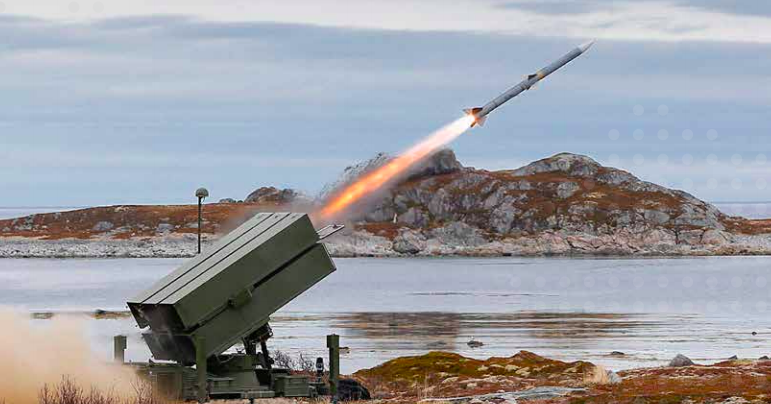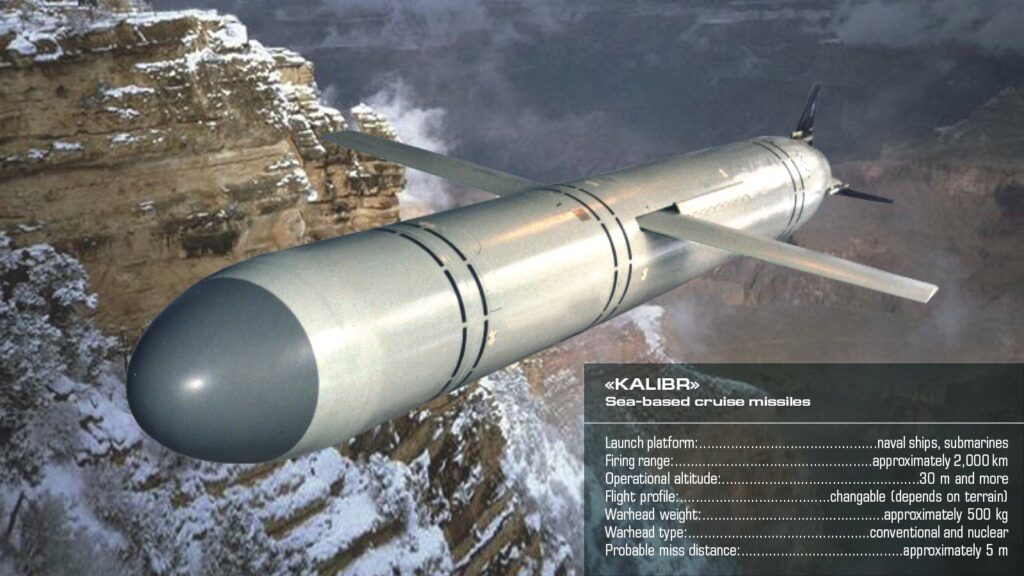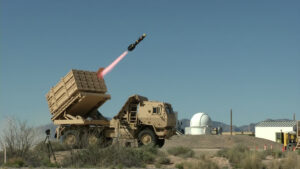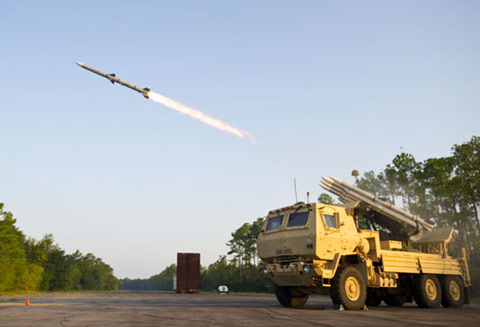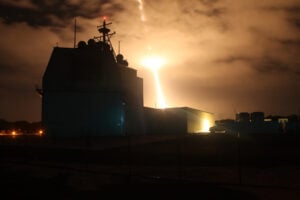SASC NDAA Would Add $500M For Cruise Missile Defense
Posted on
WASHINGTON: The Senate Armed Services Committee has lost patience with the Army program to develop cruise missile defenses, IFPC, and reallocated $500 million to buy an off-the-shelf alternative by 2020. The system would defend US bases abroad from Russian, Chinese, Iranian, or North Korean strikes.
While the bill language and SASC staff are careful not to choose favorites, they’re clearly inspired by foreign-built systems such as the Norwegian NASAMS, which has quietly defended Washington, DC since 2005. (Most of the details are classified). Another option we’ve heard is the Israeli-built, US-subsidized David’s Sling missile, big brother to the more famous Iron Dome.
An American Achilles’ Heel
While the US military has invested massively in defense against ballistic missiles — such as GBI, THAAD, and Patriot — it’s largely neglected cruise missiles, which fly completely different flight paths and present a different kind of target. ICBMs, Scuds, and similar launch on a plume of hot exhaust visible from space and then fly a completely predictable ballistic path — hence the name — so they’re (relatively) easy to spot. But they fly so fast and high they’re hard to hit, requiring highly specialized high-performance interceptors.
Cruise missiles, by contrast, are essentially kamikaze drones, unmanned aircraft on a one-way mission. Compared to ballistic missile, cruise missiles fly low and slow, making them hard to spot but, once spotted, (relatively) easy to shoot down with high-end anti-aircraft weapons. In World War II, the British routinely downed the world’s first cruise missile, the V-1, with propeller-driven Spitfires. Today, the NASAMS uses a variant of the AIM-120 anti-aircraft missile widely used by fighter jets.
But if you can stop cruise missiles with standard air defenses, why is there a problem? It’s because the US Army largely disbanded its air defense force after the Cold War and is now struggling to rebuild it. Iraqi guerrillas, the Taliban and the Islamic State didn’t have air forces, so all US forces needed was Counter Rocket, Artillery, & Mortar (C-RAM) defenses — derived from the Navy’s Phalanx — and, later, Counter Unmanned Aerial System (C-UAS) defenses against drones.
The Russian threat has driven the US Army to mount anti-aircraft missiles on 8×8 Stryker armored vehicles for what’s called Maneuver Short-Range Air Defense. The first M-SHORAD battery should enter service in 2020, and the SASC “commends” the Army’s efforts in its report language. But M-SHORAD is aimed against drones, helicopters, and frontline attack jets — not cruise missiles.
Cruise missile defense is supposed to be part of IFPC, which uses a larger truck-mounted Multi-Mission Launcher (MML) able to fire a range of missiles against a variety of targets. IFPC has been accelerated too, with first fielding in 2021. However, the command-and-control network it depends on to get targeting data, IBCS, has been delayed repeatedly and won’t enter service until 2022.
“By attempting to leverage the IBCS system for IFPC, the Army exposes itself to additional delays if certain testing milestones are not achieved on time,” notes the SASC report. “The committee is not confident that the Army will successfully deliver an IBCS system on its current timeline.”
That’s not the only fault the Senate finds with IFPC: “The Government Accountability Office has stated that (IFPC) has struggled with integration of all four components –the Sentinel radar, the AIM-9X interceptor (a shorter-ranged cousin of the AIM-120 used by NSAMS), the IBCS fire control, and the multi-mission launcher (MML).”
A Norwegian Alternative?
So the Senate bill cuts $500 million from multiple places — there’s no one easily identifiable offset — and allocates it to “acceleration of cruise missile defense.” Technically, this item falls under IFPC procurement, increasing it from not quite $146 million to over $645 million. (There’s another $30 million added to IFPC research, development, testing, & evaluation, for a total of $81 million). But the statutory language makes clear the $500 million isn’t for accelerating IFPC in its current form.
Quite the contrary. “The Army shall deploy an interim, fixed site cruise missile defense capability, in anticipation of delivery to the Army of the Indirect Fire Protection Capability (IFPC),” the bill states. Note that IFPC is truck-mounted and thus mobile, though not a frontline system like M-SHORAD; this interim “fixed site” system is purely for base defense. “Up to $500,000,000 may be available for the deployment of the interim capability” — not, in other words, for IFPC proper.
SASC wants the first two batteries of the interim system deployed by September 2020 and two more by September 2023, preferably to air bases and significant fixed site locations in Europe and Asia.” To meet that deadline, it instructs the Army to “deploy systems that require the least amount of development (or are) currently in production (or) already in the Joint Force inventory.”
While there are multiple cruise missile defense systems on the market, there are only two in US service: the Navy’s Aegis, normally fitted on ships but being installed at sites on land in Romania and Poland; and NASAMS, which is already integrated with the Washington, DC-area air defense network and routinely operated by Army National Guard soldiers. Given how fast the Senate wants this capability fielded, how hard it can be to tie systems together for the first time, and how long it takes to train soldiers on something new, incumbency gives NASAMS a huge advantage with the Army.
Depending on who’s talking, NASAMS stands for either Norwegian Advanced Surface-to-Air Missile System — the original English-language name chosen by the inventors, Kongsberg — or National Advanced Surface-to-Air Missile System — as preferred by Kongsberg’s American partner, Raytheon. It entered Norwegian service in 1994 and has since been sold to Finland, Spain, Oman, Lithuania, and Indonesia as well as the US (in 2005). Its main weapon against cruise missiles is the AIM-120 but different models of NASAMS can fire different missiles.
NASAMS also includes its own radars, datalinks, and fire control, but the system defending DC is integrated with a wider array of US networks. How does this function? That’s classified. In fact, Hill sources wouldn’t even name NASADS until we pointed out its presence in DC is public record, although past coverage has focused on its anti-aircraft capability rather than cruise missile defense.
While the interceptor is important, said Tom Karako, head of the missile defense program at CSIS, “the big challenge is the radar and command-and control.”
“The other dog that isn’t barking here is a persistent, overhead radar with a long range–cough, JLENS, cough,” Karako wrote archly. He’s referring to the blimp-borne JLENS radar, specifically designed to counter cruise missiles. The program was cancelled after a blimp broke loose from its moorings, blew away, and crashed — but no one has yet figured out a better way to suspend a radar over a region indefinitely without needing to land to refuel like a drone or airplane.
So NASAMS or another foreign system like David’s Sling could well be part of the solution to cruise missile defense. But the really hard part is seeing the missile coming in the first place, tracking it, and transmitting that targeting data to the interceptor. That’s a problem no single purchase will fix.
Subscribe to our newsletter
Promotions, new products and sales. Directly to your inbox.

